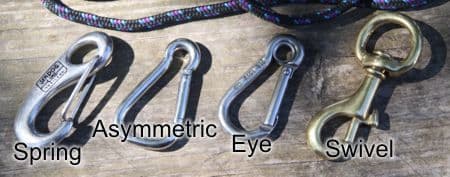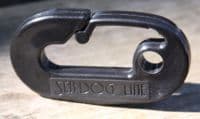Clips, Clamps and Cleats…
Kayakers from antiquity utilized deck space for storing gear, namely hunting and fishing accessories. Space was an especially limited commodity on Greenlandic kayaks that, by design and function, offered very little room beyond that for the paddler. By necessity, if you wanted to bring it along, it had to go on the deck. Greenlanders had many more deck lines on their crafts than did their Pacific Rim counterparts.
Most of the attachment points were merely places along a series of lines running laterally along the deck where an implement could be secured by shoving its tip or end under a deck line and letting the tension of that line hold the implement fast. One innovative way to quickly get an edge up and under the fairly snug line was to place a bead made from ivory or bone on the line to raise it up from the surface just enough that the diameter of the bead created a space large enough to easily and quickly start the feed of that tip or blade under that deck line (see article on Deck Line Beads for more historical information).
Today's kayak manufacturers, whether their creation is made of the cheapest poly’ plastic or the strongest tech fibers, know to add adequate attachment points for lashing, lacing, lining out lines along and across the deck of one's kayak. Simple advances in forming molded boats now enables manufacturers to recess deck loops and other fasteners or guides so decks are flush.
Still there are times when you just need an extra hole to feed a bungee through, or a simple guide to help route a line from point A to point B without bisecting a hatch cover or getting sawed through by a rudder cable. For those times the paddler can turn to a plethora of nylon, rubber and plastic hooks, cleats, clips, clasps and other guides and attachments to configure the lines on a boat into almost any pattern imaginable.
Here is an introduction to a wide field of clips, clamps and cleats that have been developed especially for the marine environment and that would serve a kayaker well for any deck or upper hull applications.
GENERAL CHARACTERISTICS
Almost all marine hardware needs to stand up against the elements, namely salt, water, UV and perhaps extreme cold or at least extreme changes in temperature. Most are made out of nylon, some form of polymer plastic or stainless steel. They are usually fastened to the deck with stainless steel bolts, a lock nut with a nylon insert and sometimes even a dab of silicone glue.
50 years of lightweight, maneuverable, high-performing kayaks.
Check out this interview with Tom Keane, Eddyline Kayaks Co-Owner, on their journey!
CLEATS
These are perhaps the most common piece of tie-down hardware in the maritime world. Nearly every larger dock at every port has the open base cleat staged along its entire length. Some can accept a rope the size of sailor’s arm while mini cleats look like they were designed for a shoe lace.
- CLAM CLEATS – Basically a pair of parallel surfaces that constrict the passage of line running through it, holding it fast in one direction only. Small ridges are aligned perpendicular to the linear flow of the rope, and at a slight angle. Any pressure against the ridges crimps the line enough that it can’t continue to run. Clam cleats are often mounted just aft of the cockpit and are used to keep tension on rudder retrieval lines on kayaks. Various sized accommodate various line diameters. They are typically molded plastic.
- CLAM CLEAT, FINE LINE, STARBOARD – These are a variation on the deck top clam cleats as they perform the same way for the same purpose. The difference is that these have a lower profile, lying more flush to the deck, or to the hull just beyond the coaming. The "starboard" designation suggests that these are places on either side of the boat to accommodate any tension lines running alongside. I’ve seen these particular cleats used to hold sheets coming off the sail rigging.
- CLAM CLEAT LINE LOKS - These are simply small cleat-shaped loks used to keep tension on a guy rope on a tent or other similar application. They are designed to serve the same purpose as those tiny aluminum sliding clips that are used to tighten up tent guy lines.
- ZIG-ZAG CLEAT – These are perhaps the beefiest cleats for kayakers and even canoers as they are primarily used to secure an anchor line. Four deep grooves grab line securely as it zig-zags its way across these restraints. Helping grab hold are a series of smaller ridges on the inner channels similar to those on a Clam Cleat. While there is no official weight range, I would feel very comfortable hanging my 12-15 pound mushroom anchor from its clutches.
- OPEN BASE CLEATS – These are probably what most people visualize when "cleat" is mentioned. You'll see these all along docks throughout the waterways of America. On kayaks, they were initially used to provide a tie-off for paddles laid across the deck. A major concern arising from using these cleats is the fact that it stands up off the deck with two stout, gear and cloth hooking flanges poking out each side. They come in a variety of sizes and materials.
LINE GUIDES
Sometimes we just need to direct a line across or along the deck. To make sure it continues to go in a particular direction we can mount a variety of line guides to maintain whatever route we need.
DECK LINE GUIDE SLOTTED ROUND -
Image two lines converging on your deck, each at an oblique angle to the other and each needing to be directed at some oddball angle at that convergence. That's what slotted round guides do. They enable two lines to converge and then diverge off at a range of weird angles – limited only by the size of the line and the width of the slot.
DECK LINE GUIDE OPEN ROUND –
These are little mushroom-shaped guides that stand ready (literally) to let you bend a line or bungee off onto any direction you want. You can use them alone or in combination with a lashing hook to virtually set a course for line along the entire length of your boat.
LASHING HOOK – Looking like a husky shoelace hook, a lashing hook does about the same thing, it grabs a line and lets you direct it while maintaining tension to another guide. It could be used to catch and hold a length of bungee to help hold a hatch in place or secure a spare paddle to your deck.
SNAP HOOKS
Eventually a line will have to be connected to something. While a good mariner can usually do so with a variety of knots, an enclosed hook at the end of the line would makes things a lot faster for most everyone.

- SWIVEL EYE BOLT SNAP – Usually made of brass or stainless steel, this snap can be found in myriad places outdoors: clipping leash to dog collar, clipped to an eyebolt on the bow of a fishing skiff and probably a hundred places on a sail boat. It’s fast, easy and serves the general purpose of securing a line to anything with a loop very well. They are rather clunky, especially for kayaks and canoes. There are plenty of cousins of the swivel eye to meet the calling.
- SNAP HOOK WITH EYE – Your basic spring gate snap with an eyelet collar instead of the bare eye of the snap. The eye offers some added protection should the gate fail since the line is secured inside the eye, itself secured within the bend (eye) of the snap. These are especially good to use at the end of a tow rope.
- SPRING GATE SNAP HOOK – A basic hook with an especially large gate for very easy attaching. I don't think these are particularly strong but they are more secure than a regular hook without the wire gate closure.
- ASYMMETRICAL SNAP – Simply straightening out one side of the large eyelet increases the stretch of this snap by 50 percent! That's its claim to fame – use it when you just need some more muscle to hold that line in place.
- SKI TOW SNAP –
Who knows what you might want to snap onto at sea. With this big, stout but lightweight snap you can be reasonably assured of securing your load. Another advantage – its got about the same strength as the Snap Hook with eye insert, at about 1/4 the cost ($4 vs. about $16).

STORAGE/STOW CLIPS
- POLE STORAGE CLIP – Simply a big clip that will let you store your paddle up pretty much flush against a wall or other flat surface. Wherever you want to hang a paddle. It's also handy for rakes and shovels should you answer to that calling.
- FOLDING PADDLE CLIPS –
A clip that folds, not a clip for a folding paddle, although it could be! The variety of sizes suggests uses beyond the paddle, and beyond boat use for that matter. What's nice about these clips is the fact that they fold down out of the way when not is use.
They could be mounted on the aft deck and pulled up into service to stow a spare paddle. A really novel use for them is to mount the clip onto a cylindrical piece of equipment (flashlight, bear spray, whatever) and have fold out, clip to the nearest pipe – or even nearby branch. The sizes are conveniently sequenced to provide a wide range of applications.
DECK FITTING BUNGEE BLOCK
Sometimes things just break and you need to keep the line continuous. If you have a couple of bungee that just won't quite reach or if you have to cut out a worn section without unlacing the entire deck, consider a deck fitting bungee block. Simply feed in both ends from opposite directions, tie a knot to secure the end so it won't pull through the feeder hole, and then stretch the lines back out securing the knots deep within the molded body.
The block lies fairly flat on the deck and, should it be on a bungee or line crossing your deck, it might lift the line just enough to mimic those bone beads of yore.
ONE MORE THING…
Even thought adding a cleat, clip or clamp to your boat is a simple task, you can ruin a deck by a poorly drilled hole that might splinter or crack the deck. The wrong glue might react negatively with the plastic. Depending on the tension, the wrong direction or even the wrong clamp/cleat/clip could cause damage.
Adding clips and such is an easy way to customize your boat to suit your own needs. Never compromise safety.
VERY SPECIAL THANKS TO: Ryan Hanegan, at SEA-LECT DESIGNS for his technical support and assistance in developing this article. Check out even more clips, cleats and clamps at www.sealectdesigns.com.
Have fun and be safe out there!
Tom Watson is an avid sea kayaker and freelance writer. He also posts articles and thoughts on his website www.wavetameradventures.com. He has written 2 books,"Kids Gone Paddlin" and "How to Think Like A Survivor" that are available on Amazon.com.
Related Articles
I am sure by this point in your paddling adventures, you have heard the term dirtbag. Dirtbags are often…
Wing foiling is the next up and coming trend within the standup paddleboard community. Combine your SUP,…
We've all been there. The dreaded portage. Sure, we knew there'd be a brief portage here and there, but…
Whether for a loved one or yourself, the holidays are a perfect time to get ready for next year's…



